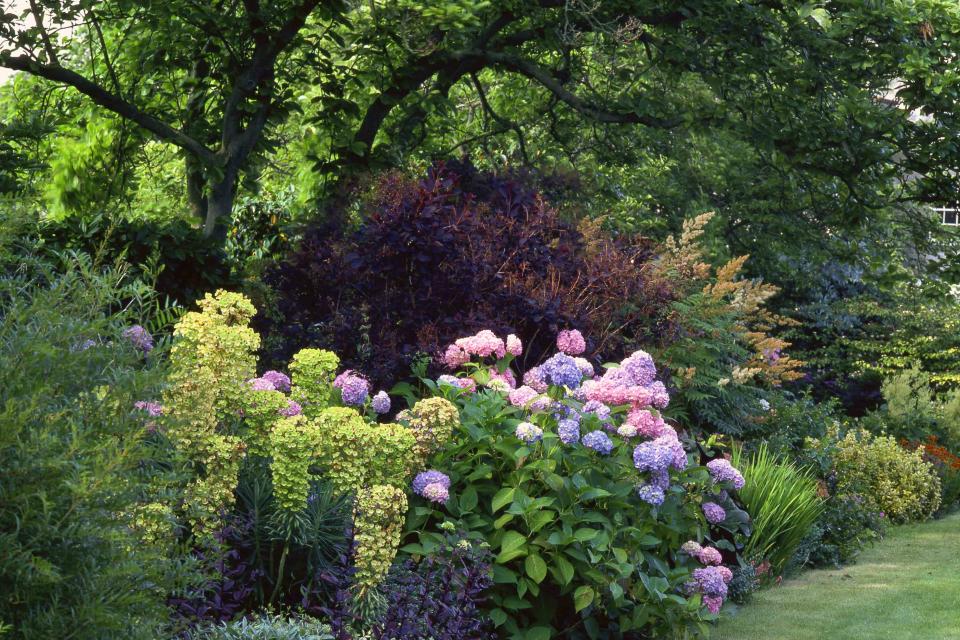9 Expert Tips for a Successful Shade Garden
Because too much sun isn't always a good thing.

Michel Viard/Getty Images
Many people consider shade a bane to gardening, but it doesn’t have to be. In fact, some gardeners even prefer shade to a sunny site, including garden designers Susanna Grant, the author of Shade, a part of the Bloom Gardener’s Guide series, and Amy Ziffer, the author of The Shady Lady's Guide to Northeast Shade Gardening.
“Shade creates cooler, restful environments that are a pleasure to retreat to (or even work in!) during the heat of summer,” says Ziffer. Not only is shade pleasant to be in, it is essential. “I think we should be encouraging more shade into our gardens,” says Grant. “As the temperatures are rising we need to be providing shade for ourselves, plants, and wildlife.” We asked Grant and Ziffer to share their passion for shade and tips for success; here is their advice.
Related: 4 Shade-Loving Perennials That Need Barely Any Sunlight
Determine What Kind of Shade You Have
“Not understanding what shade you have is a common mistake,” says Grant. Study your light conditions to determine where you fall on the established shade scale.
Definition
“Partial shade” is less than five hours of direct sun, “full shade” is one hour or less of direct sun (plants may receive filtered light throughout the day or in spring before deciduous trees leaf out), and “deep shade” means almost no direct sunlight at all times, such as beneath a canopy of evergreen trees or near a tall building.
Know Your Moisture Conditions
Light isn’t the only factor you need to consider when choosing plants: Moisture is also key. “A common mistake is thinking that shade gardens won’t be as dry as gardens with direct sun exposure,” says Ziffer.
She adds, “Shade gardens can become painfully dry, and you have to maintain an awareness of conditions.” But don’t assume dry shade means you need irrigation—there are many plants adapted to dry shade, it’s just a matter of doing your homework.
Include Some Evergreen Structural Plants
Once you have an idea of how much light and moisture you have, you are in a much better place to choose plants that will succeed. Grant suggests starting with some that are evergreen that will provide structure.
Grant, who gardens in Zone 9a, suggests Snowy wood rush (Luzula nivea), a small-ish grass, Robb’s spurge (Euphorbia robbiae), a perennial for tough, dry shade, and Alpine wood fern (Dryopteris wallichiana), which she calls “a beautiful large fern.” You can ask your local nursery for suggestions for your area.
Related: Here's a Full Guide to the USDA Gardening Zones
Pay Attention to Foliage Shapes and Color
Foliage plants are the backbone of shade gardens, so train your eye to focus on leaves—not just flowers. “Foliage shapes are important in any garden but probably a bit more important in a shade garden, as you may have less flowering,” says Grant, who notes, “Different shades of green are really noticeable in a shady spot and can provide lovely contrast and are calming to look at.”
Start Small
It’s tempting to buy the biggest plants you can afford at the nursery for instant gratification, but if you are planting where there are substantial tree roots, Ziffer says the best approach is often to start with smaller plants (plugs or quarts, not gallon pots).
Tips
Choosing smaller plants will minimize tree root disturbance and increase the chances of the transplant’s survival. Those smaller plants may be slower to establish than in a sunny garden, but Grant says, “This doesn't mean they are not happy and won't thrive, they are just taking their time.”
Broaden Your Plant Palette
If you can’t summon enthusiasm for shade gardening, you may just need to widen your palette of plants. “Shade gardens are not just foliage gardens,” says Grant, who notes that foxglove (Digitalis lutea), white wood aster (Eurybia divaricata), knotted cranesbill (Geranium nodosum), and Cicely (Myrrhis odorata) are all good shade plants for the Northeast that will give you flowers through the season.
You might also consider unusual varieties of familiar plants, for example, Grant is currently excited by whorled Solomon's seal (Polygonatum verticillatum rubrum), an elegant variety of Solomon's seal with dainty, dusky pink bell-shaped flowers.
Expect a Shorter Blooming Season
“A majority of shade-adapted plants, whether native or not, bloom in spring,” cautions Ziffer. If you have an expectation of non-stop flowering, you will probably be disappointed, but Ziffer says, three-season flowering is something that can only be achieved with effort.
Ziffer suggests shade gardeners learn to appreciate “the natural aesthetic of a forest environment, which isn’t what the gardening community has historically regarded as desirable.”
Learn How to Use Native Shade Plants Effectively
“When plants are delicate, as shade plants often are, pairing them suitably—as opposed to monocultural massing—is often key to getting a good impression,” says Ziffer.
For example, she says early meadow-rue (Thalictrum dioicum), a plant with understated flowers and lace-like foliage, makes an excellent foil for wild geranium (Geranium maculatum) and other woodland species when loosely interplanted.
Related: Garden Designers' 9 Favorite Flower Pairings For a Gorgeous Landscape
Don’t Get Stymied
You want to choose plants well-adapted to your conditions, but don’t obsess about the exact right plant. “Start somewhere and over time, your understanding will deepen,” says Ziffer. “Expect to have failures, because nothing—no reference book or advice column—can take the place of raw experience. You simply have to plant and observe and really think about why you succeeded or failed.”
For more Real Simple news, make sure to sign up for our newsletter!
Read the original article on Real Simple.


